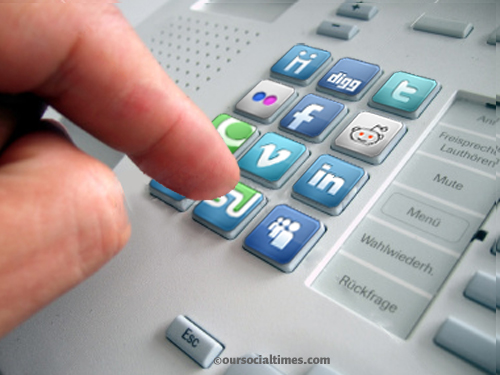VentureBeat recently reported that while 62 percent of consumers use Twitter, Facebook and other channels to broadcast service complaints, a vast majority of those messages never receive a response. If your company is among that majority, you could be setting yourself up for public relations disaster.
Until recently, there wasn’t much help in the software department for solving this disconnect. Most “social listening” platforms are geared toward bigger-picture marketing functions, such as sentiment analysis and outbound promotion. This does nothing to help customer service teams respond in real time to service complaints voiced in social media.
More recently, call center and customer service vendors have stepped with social listening tools that actually identify, prioritize and route social complaints.

(Photo credit: oursocialtimes)
Social Dynamx
“From a cost perspective, social is an effective means of call deflection. Calls can cost between $30-$40, where a social response is closer to $3-$5.” – Heather Strout, Social Dynamx customer insights manager
Social Dynamx uses role-based interfaces to automate social message routing. The system considers agent expertise, work group, current caseload, average time to respond, and service satisfaction rate. The platform might, for example, choose a top service-rated agent to handle a strongly negative issue.
Users can easily change or add expertise as needed. Imagine if a company were suddenly flooded with tweets about a defect in a certain product. The customer service team could create a new work group and tag corresponding agents as the sole recipients for tweets related to that issue.
Salesforce Social Hub
Salesforce.com launched The Social Hub last year after acquiring social monitoring platform Radian6. The system uses customized keyword identifiers to extract customer service requests from more than 150 million social networks, blogs, forums and other sources. It scans for messages that combine #CompanyName, @CompanyName and brand mentions with customer service-related triggers. This includes generic words like “help” or “need assistance,” or specific phrases like “My cable is out.”
These requests are then automatically prioritized according to content and the customer’s purchase history and social activity level. A computer manufacturer company might, for example, place higher value on a key social media influencer or brand advocate who recently purchased ten laptops, and bump his help request to the top of the queue.
LiveOps Social
LiveOps Social is Cloud-based contact center software that processes social service requests exactly like tickets submitted through voice, email or the Web. It searches for requests by Twitter hashtag or keyword, or by designated Twitter and Facebook accounts. Once LiveOps identifies a request, it creates a ticket that shows up in the service queue along with requests from other channels.
The work item is synchronized with other relevant customer data to prioritize the request, including service and social history. When an agent views the next work item routed to them they can see the overall context to understand a customer’s contact experience. As LiveOps continues to improve routing, a social request for example, might be flagged as critical if the system sees that customer called the hotline, emailed three hours ago, and just tweeted about how they couldn’t get a hold of anyone.
Social Media Spaces by Moxie Software
Many companies only respond to the angriest customer complaints posted on Twitter. This is a bad move, according to Moxie Software Marketing Vice President Tara Sporrer.
“You want damage control, but you don’t want to train your customers by only responding to irate messages,” she says. Usually, when customers are vocal on social media, it means that other more established communication channels have failed in providing them the support they needed. Finding the right balance takes constant trial and error.
Social Media Spaces allows supervisors to analyze social response data so they can constantly tweak prioritization and routing rules. The dashboard uses metrics such as social customer satisfaction, first contact resolution and ticket rerouting rates.
Research for this article was provided by Software Advice, a website that reviews and writes about help desk software.
Ashley Furness has spent the last six years reporting and writing business news and strategy features. Her work has appeared in myriad publications including Inc., Upstart Business Journal, the Austin Business Journal and the North Bay Business Journal. Before joining Software Advice in 2012, she worked in sales management and advertising. Currently, her research focuses on various topics related to CRM software, sales, customer service and marketing strategy.





